|
| |
| |
| Reviews |
| |
thefastertimes.com
Bollywood and Bharata Natyam in Lower Manhattan |
| |
| |
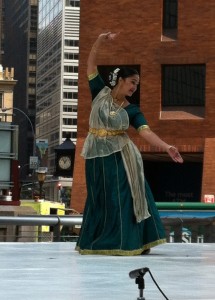
Bageshree Vaze, a Kathak dancer at the Downtown Dance Festival. All photos by yours truly. |
Summer in New York means free art en plein air. Often, it’s too hot and sticky to really enjoy oneself—one simply sweats and suffers. Other times, the offerings are, well, not to everyone’s taste (a recent Finnish fusion of wrestling and accordion playing comes to mind). And sometimes, well, it’s just the thing on a Friday afternoon around lunchtime. The yearly Festival of Indian Dance, co-sponsored by the Indo-American Arts Council and the Downtown Dance Festival, is one of the most dependable of these summer outings. (The Downtown Dance Festival is produced by Battery Dance Company). This laid-back, engaging event includes performances by specialists in several of India’s classical dance forms based in Canada, India, Russia, and New York. This year it even had Bollywood dance. High and low mixed happily. The diaspora of Indian dance, which follows the roads of immigration as well as that of Indian popular culture, is remarkable. My only regret was that, by necessity, all the music was recorded. With Indian dance, in which the lively repartee between the dancers’ feet and musicians’ rhythms plays such an important part, something is lost. |
|
| |
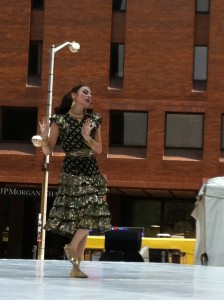
Ksenia Sigalova of Mayuri Dance, in "Mera Naam Chin Chin Chu." |
There were four participants this year: Mayuri Dance Co., Jaikishore & Padmavani Mosalikanti, Bageshree Vaze, and Sonali Skandan & Jiva Dance. (There were meant to be five, but at the last minute, one group was unable to obtain the necessary paperwork from Homeland Security. A shame.) The most curious of the four was perhaps Mayuri, a Russian troupe from Petrozavodsk, which turns out to be the capital of Karelia, in northern Russia.Can one imagine a more unlikely place to find a company sweating through high-energy Bollywood routines? Russia certainly has a strong tradition of dance, and the women of the company were remarkably polished, graceful, and enthusiastic.It only added to their charm that one of the dancers looked so much like a Russian doll, and another bore a vague resemblance to Natalia Osipova, with her pale skin, enormous eyes, and jet back hair. Ksenia Sigalova, who seemed to be one of the leads, had extraordinarily lively eyes, and lip-synched every song. She danced what, to me, was the group’s most appealing contribution, a rock-and-roll number with the delightful title Mera Naam Chin Chin Chu (from the 1958 film Howrah Bridge) and the refrain “Hello Mister, How do you do.” |
|
| This Indian-tinged jitterbug reminded me of myriad dance sequences in Italian films of the same period (a genre particularly dear to my heart), like Guarda Come Dondolo (from Il Sorpasso) and Renato Carosone’s infectious Tu Vuò Fa L’Americano. The allure of 1950’s American culture seems to have been nearly irresistible. I found a video of the original song, performed by Helen Jairag Richardson, on YouTube: http://youtu.be/yLmnyLELYWo |
| |
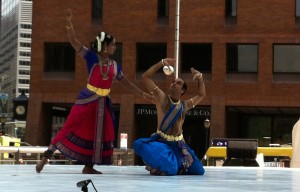
Jaikishore and Padmavani Mosalikanti, in Durga Taranga. |
Jaikishore and Padmavani Mosalikanti, a couple from Chennai specializing in kuchipudi, performed Dura Taranga, a dramatic dance which tells the story of the goddess Durga slaying the buffalo-headed demon Mahishasura. New York has had the good fortune lately of hosting several performances by Shantala Shivalingappa, a Kuchipudi dancer and choreographer of extreme sophistication and elegance. Shivalingappa performs alone, in mesmerizing evenings that spin a kind of carefully-wrought spell. What struck me about this couple’s performance was how different it was from Shivalingappa uber-refined dancing. |
|
| This dance-drama had the feel of popular theatre. That is not meant as a criticism; what they may have lacked in pristine, serene delivery and understatement they made up for in animated theatricality. The battle scene, in particular, wonderfully vivid. |
| |

The singer and dancer Bageshree Vaze. |
Bageshree Vaze, an extremely beautiful dancer and singer, performed two Kathak pieces, both accompanied by recordings of her own vocal music. Her arm movements were sinuous and lovely, but the choreography was not particularly dynamic, and Vaze’s footwork lacked rhythmic incisiveness. Her particular skill seemed to be the ability to perform a dizzying number of lightning fast pirouettes with changing points of focus, and in every direction. During her performance, I noticed a woman next to me counting out the beats of the complex rhythms on one knee with her hand. The engagement of the crowd created a welcome family-feeling, especially in the middle of the day in this oddly concrete-filled environment, surrounded by tall buildings in the Financial District. One New York Plaza, where the performance took place, contains a small esplanade beneath a giant office building which provides just the right shade for dancers and audience alike. On this hot, muggy day, the particular configuration of buildings, and proximity to the water, created a pleasant breeze; it was an agreeable place to while away a couple of hours. Office-workers peeked through the windows longingly. |
|
| |
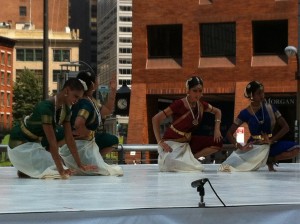
The dancers of Sonali Skandan & Jiva prepare for Shiva's visit. |
The New York-based bharata natyam group Sonali Skandan & Jiva Dance went next, with a series of ensemble dances displaying the graceful curves, circling torsos, deep pliés, and animated eyes that make this dance-style so pleasing. This group was the most varied, both in physique and in level of ability. The Nigerian-born Njideka Avesta Emenogu, who has studied bharata natyam in this country since the age of nine, stood out in particular for the dynamism of her poses and the clarity of her movements. The ensemble performed three works, of which the most vivid was perhaps Shadjam, a vignette that depicted a groupof girls preparing for a visit by Shiva, |
|
| in his lover-man guise. As they combed each other’s hair and praised each other’s beauty (in mime), I could see the next group preparing in a tent off-stage, busy with similar tasks. For a moment, art intermingled with life. |
| |
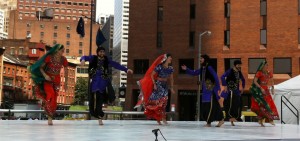
A vigorous bhangra by Mayuri closes the show. |
In the final number, the Russian dancers of Mayuri Dance Co. returned for a folk-inspired bhangra dance, in which half the women were dressed as men, complete with clownish paste-on beards. But for the music, it could have been the danse indienne from Russian versions of La Bayadère (eliminated, alas, from Makarova’s more upscale staging), all pounding feet, leaps, and cartoonish expressions. It was straight dance-hall, and it was great fun. |
|
| |
| |
| Source: http://www.thefastertimes.com/dance/2012/08/17/bollywood-and-bharata-natyam-in-lower-manhattan/ |
|
|
| |
|
| The Indo-American Arts Council is a 501 ©3 not-for-profit secular arts organization passionately dedicated to promoting, showcasing and building an awareness of artists of Indian origin in the performing arts, visual arts, literary arts and folk arts. For information please visit |
| |
|
|






